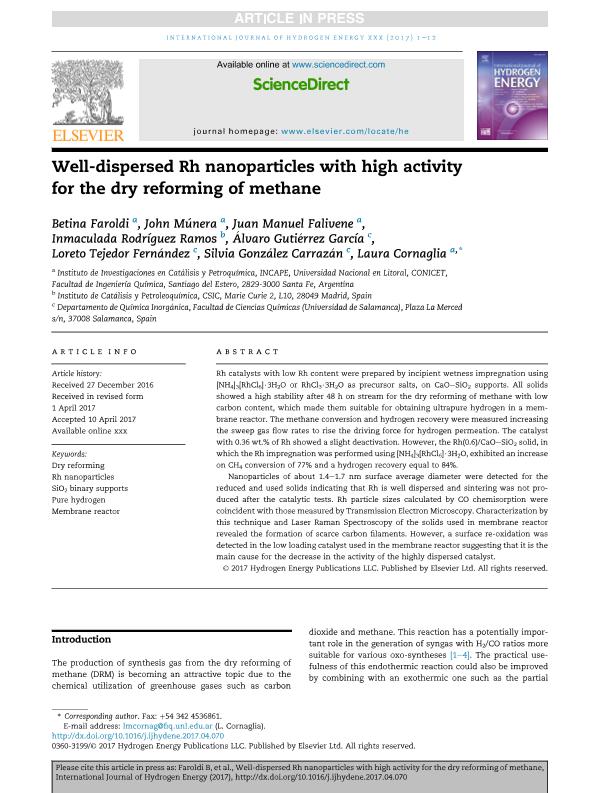Artículo
Well-dispersed Rh nanoparticles with high activity for the dry reforming of methane
Faroldi, Betina María Cecilia ; Gómez Múnera, John Anderson
; Gómez Múnera, John Anderson ; Falivene, Juan Manuel; Rodríguez Ramos, Inmaculada; Gutiérrez García, Álvaro; Tejedor Fernández, Loreto; González Carrazán, Silvia; Cornaglia, Laura Maria
; Falivene, Juan Manuel; Rodríguez Ramos, Inmaculada; Gutiérrez García, Álvaro; Tejedor Fernández, Loreto; González Carrazán, Silvia; Cornaglia, Laura Maria
 ; Gómez Múnera, John Anderson
; Gómez Múnera, John Anderson ; Falivene, Juan Manuel; Rodríguez Ramos, Inmaculada; Gutiérrez García, Álvaro; Tejedor Fernández, Loreto; González Carrazán, Silvia; Cornaglia, Laura Maria
; Falivene, Juan Manuel; Rodríguez Ramos, Inmaculada; Gutiérrez García, Álvaro; Tejedor Fernández, Loreto; González Carrazán, Silvia; Cornaglia, Laura Maria
Fecha de publicación:
06/2017
Editorial:
Pergamon-Elsevier Science Ltd
Revista:
International Journal of Hydrogen Energy
ISSN:
0360-3199
Idioma:
Inglés
Tipo de recurso:
Artículo publicado
Clasificación temática:
Resumen
Rh catalysts with low Rh content were prepared by incipient wetness impregnation using [NH4]3[RhCl6]·3H2O or RhCl3·3H2O as precursor salts, on CaO–SiO2 supports. All solids showed a high stability after 48 h on stream for the dry reforming of methane with low carbon content, which made them suitable for obtaining ultrapure hydrogen in a membrane reactor. The methane conversion and hydrogen recovery were measured increasing the sweep gas flow rates to rise the driving force for hydrogen permeation. The catalyst with 0.36 wt.% of Rh showed a slight deactivation. However, the Rh(0.6)/CaO–SiO2 solid, in which the Rh impregnation was performed using [NH4]3[RhCl6]·3H2O, exhibited an increase on CH4 conversion of 77% and a hydrogen recovery equal to 84%. Nanoparticles of about 1.4–1.7 nm surface average diameter were detected for the reduced and used solids indicating that Rh is well dispersed and sintering was not produced after the catalytic tests. Rh particle sizes calculated by CO chemisorption were coincident with those measured by Transmission Electron Microscopy. Characterization by this technique and Laser Raman Spectroscopy of the solids used in membrane reactor revealed the formation of scarce carbon filaments. However, a surface re-oxidation was detected in the low loading catalyst used in the membrane reactor suggesting that it is the main cause for the decrease in the activity of the highly dispersed catalyst.
Archivos asociados
Licencia
Identificadores
Colecciones
Articulos(INCAPE)
Articulos de INST.DE INVEST.EN CATALISIS Y PETROQUIMICA "ING. JOSE MIGUEL PARERA"
Articulos de INST.DE INVEST.EN CATALISIS Y PETROQUIMICA "ING. JOSE MIGUEL PARERA"
Citación
Faroldi, Betina María Cecilia; Gómez Múnera, John Anderson; Falivene, Juan Manuel; Rodríguez Ramos, Inmaculada; Gutiérrez García, Álvaro; et al.; Well-dispersed Rh nanoparticles with high activity for the dry reforming of methane; Pergamon-Elsevier Science Ltd; International Journal of Hydrogen Energy; 42; 25; 6-2017; 16127-16138
Compartir
Altmétricas



